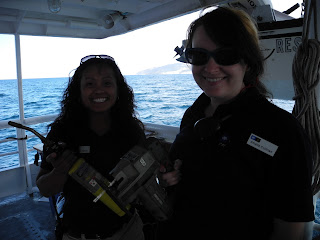
This is what happens when you leave your camera laying around the ship! El Capitan might scoop it up for a candid shot!
Captain Mark Graves is the Master of the Seabird and is in charge of everthing. He is great to work with and you feel safe with him at the helm. Capt. has just retired with his wife, Michele, after 21years with the company for a little sailing of his own. He will be missed.
 First Mate
First Mate, or
Chief we call her is
Kendra Lei Nelson. She is second in command of the ship and is a very good friend of mine. Kendra is in charge of all the deckhands and outside workings of the vessel as well as the safety officer. If you get hurt, she fixes it!
 Alexis
Alexis is
3rd Mate of the Seabird. She is in charge of all the kayak opperations onboard and making sure everyone knows where all the safety equipment is, like fire extinguishers! She is also my workout buddy. We try to do daily exercises onboard. We have to get creative on a moving boat!

Deckies!!!! Here are two of the four most valuable players onboard,
Deckhands. Sheryl and Amelia. If you loose it, they find it. If you break it, they fix it. The deckhands work the hardest of hours. 12 on/12 off around the clock. There is always 2 up in the middle of the night making sure everything is shipshape while we sleep. They also hull the trash, check the engine room, paint the deck, load and unload passengers, etc,etc,etc. MVP`s for sure!
 Adam
Adam, the
Bosun. Adam has a very busy job buzzing back and forth from the ship in one of our 4 zodiacs full of passengers. He is in charge of all the maintenance of these little guys and well as their appearance!

Probably the most popular of all crew, Carla.
Carla is the ships
pantry chef. THE COOKIE BAKER. Her cookies are so good, she has to hide them from the crew. It`s a good thing too, because she might not have many left if she didn`t! We love Carla!

Aaaahhh the
Naturalist.
Sheran and Alberto. Here are 2 of the 6 or so Naturalist onboard. If you have a question about the outside environment they will know the answer. These guys assist the guests on their expeditions ashore as well as point out all the birds and whales that we see. They are a wealth of knowledge.

Here`s some of my crew. The
stewards!!!!! This picture is taken just before dinner service. Our job is to wait on the passengers and to tidy their rooms when they are out. Sometimes we have to work in the Galley washing dishes too. That my job next week, yikes!

Our
Executive chef, Singyn Hunter. In this picture he is spinning sugar to don the dessert for the evening. He is an excelent chef. He not only makes the meals for guests, he is in charge of crew meals too. He makes us sushi, chocolate-coconut breadpudding, nachos,Thai food. All kinds of good stuff. Gotta watch it with him onboard so you don`t gain too much weight! Check out the Galley. This small kitchen cooks for over 90 people....that`s a lot of dishes....
 Michele Graves
Michele Graves is our
Expedition Leader. Michele is a super organizer. She, with the help of her husband, the captain, plan the day for the guests. She has to take into account the direction of the wind, the tides, and the needs of the guests. Michele is a very busy lady, but not too busy to give the weary crew a ride to
la playa,(the beach) for the afternoon. Thanks Michele!

Christmas Dinner aboard the ship. We decided to set the table and have a fancy dinner before we dressed and got ready for our shift.
 I had a very special guest this week paddling. Bosco rode along with his mom Megan on a two hour kayak paddle. He even took a nap. Birding isn`t for everyone.
I had a very special guest this week paddling. Bosco rode along with his mom Megan on a two hour kayak paddle. He even took a nap. Birding isn`t for everyone.































 Deckies!!!! Here are two of the four most valuable players onboard,
Deckies!!!! Here are two of the four most valuable players onboard, 





